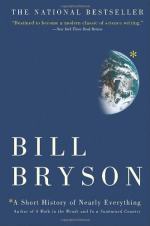
|
| Name: _________________________ | Period: ___________________ |
This test consists of 15 multiple choice questions and 5 short answer questions.
Multiple Choice Questions
1. Which of the following is not a DNA component?
(a) Guanine.
(b) Cytosine.
(c) Uracil.
(d) Adenine.
2. Scientists now believe that life began on Earth how long ago?
(a) 6.25 thousand years.
(b) 5.75 million years.
(c) 3.85 billion years.
(d) 7.35 trillion years.
3. The author states that extinction seems to be:
(a) Almost exclusively caused by humans.
(b) A rare occurrence on Earth.
(c) A natural part of the life cycle.
(d) Because of natural disasters.
4. Humans share 98.4 percent of their DNA with:
(a) Chinchillas.
(b) Lemurs.
(c) Chimpanzees.
(d) Lions.
5. Photosynthesis was developed during the early history of life on Earth by what?
(a) Magentobacteria.
(b) Flavobacteria.
(c) Cyanobacteria.
(d) Xenobacteria.
6. What is the highest elevation that humans are able to live and survive on Earth continuously without special accommodations?
(a) 22,000 feet.
(b) 14,000 feet.
(c) 27,000 feet.
(d) 18,000 feet.
7. When entomologist Terry Erwin collected insect samples from 19 rain forest trees, how many different varieties of beetles did he find?
(a) 1,200.
(b) 42.
(c) 150.
(d) 600.
8. Charles Darwin suggested that evolution was a process taking millions of years, which many met with skepticism because scientists:
(a) Thought life on Earth had existed no more than 3,000 years.
(b) Believed only birds evolved, not mammals or reptiles.
(c) Did not like Darwin.
(d) Believed Earth to be much younger.
9. Most life on Earth is based on what element?
(a) Hydrogen.
(b) Magnesium.
(c) Iron.
(d) Carbon.
10. Anders Celsius, who designed the Celsius thermometer, was an:
(a) Engineer.
(b) Architect.
(c) Astronomer.
(d) Artist.
11. How quickly can bacteria create a new generation?
(a) Within ten minutes.
(b) Within five seconds.
(c) In forty years.
(d) In twenty years.
12. Gregor Mendel, who conducted research on transmittal of traits in pea plants, was a scientist and a:
(a) Soldier.
(b) Politician.
(c) Monk.
(d) Blacksmith.
13. In times past, Earth was:
(a) Smaller.
(b) Flatter.
(c) More hospitable.
(d) Less hospitable.
14. What was the HMS Beagle, and how was it related to Charles Darwin?
(a) A microscope given to him by his wife.
(b) A laboratory created for him by the king.
(c) A hot-air balloon he used to survey the land.
(d) A ship he travelled on, collecting specimens.
15. Who was the first person to describe a cell?
(a) Matthias Jakob Schleiden.
(b) Robert Hooke.
(c) Van Leeuwenhoek.
(d) Theodor Schwann.
Short Answer Questions
1. If Earth did not have an atmosphere, it would be what?
2. Who was Robert Fitzroy?
3. What are eukarya?
4. Somewhere between three and two million years ago, how many hominid species co-existed before vanishing abruptly?
5. The early Cambrian period, or the Cambrian explosion, refers to a time how long ago?
|
This section contains 421 words (approx. 2 pages at 300 words per page) |

|




